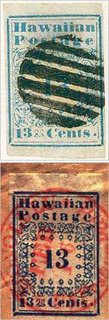Grinnell Missionaries
 One of the longest-running controversies among stamp collectors has made the main stream media.
One of the longest-running controversies among stamp collectors has made the main stream media. The New York Times reports,"Ken Lawrence and Richard C. Celler, both respected for their expertise in 19th-century stamps, have found evidence that a group of stamps long held to be fakes may be genuine and potentially worth as much as $10 million."
Times reporter Matthew Healey writes, "The discovery concerns one of the early Hawaiian stamps known as the Missionaries, printed by the islands’ nascent postal service in 1851 largely for correspondence from missionary settlers to the United States."
According to Healey, "A group of about 80 Missionary stamps was found in 1918 by a Los Angeles schoolteacher and stamp collector, George Grinnell, who believed the stamps were genuine and sold some of them to a New York dealer for $65,000. One of the dealer’s clients compared Mr. Grinnell’s stamps with genuine Missionaries and declared them fake, because they differed in details from the printed design and postmarks. In a 1922 court case, a judge agreed that the Grinnell stamps were forgeries."
Healey goes on to say Mr. Grinnell and his descendants have spent decades to prove otherwise.
Shown above in a New York Times photo is a Grinnell Missionary and cancellation (top)thought to be geniune and along with another copy which is reputed to be a fake.
To read the entire article, click here.





<< Home